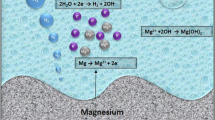Abstract
Although magnesium as degradable biomaterial already showed clinical proof of concepts, the design of new alloys requires predictive in vitro methods, which are still lacking. Incubation under cell culture conditions to obtain “physiological” corrosion may be a solution. The aim of this study was to analyse the influence of different solutions, addition of proteins and of oxygen availability on the corrosion of different magnesium materials (pure Mg, WE43, and E11) with different surface finishing. Oxygen content in solution, pH, osmolality and ion release were determined. Corrosion led to a reduction of oxygen in solution. The influence of oxygen on pH was enhanced by proteins, while osmolality was not influenced. Magnesium ion release was solution-dependent and enhanced in the initial phase by proteins with delayed release of alloying elements. The main corrosion product formed was magnesium carbonate. Therefore, cell culture conditions are proposed as first step toward physiological corrosion.












Similar content being viewed by others
References
Witte F. The history of biodegradable magnesium implants: a review. Acta Biomater. 2010;6(5):1680–92.
Erbel R, Di Mario C, Bartunek J, Bonnier J, de Bruyne B, Eberli FR, et al. Temporary scaffolding of coronary arteries with bioabsorbable magnesium stents: a prospective, non-randomised multicentre trial. Lancet. 2007;369(9576):1869–75.
Waksman R, Pakala R, Kuchulakanti PK, Baffour R, Hellinga D, Seabron R, et al. Safety and efficacy of bioabsorbable magnesium alloy stents in porcine coronary arteries. Cathet Cardiovasc Intervent. 2006;68(4):607–17.
Erne P, Schier M, Resink TJ. The road to bioabsorbable stents: reaching clinical reality? Cardiovasc Intervent Radiol. 2006;29(1):11–6.
Waksman R, Erbel R, Di Mario C, Bartunek J, de Bruyne B, Eberli FR, et al. Early- and long-term intravascular ultrasound and angiographic findings after bioabsorbable magnesium stent implantation in human coronary arteries. J Am Coll Cardiol Intv. 2009;2(4):312–20. doi:10.1016/j.jcin.2008.09.015.
Witte F, Hort N, Vogt C, Cohen S, Willumeit R, Kainer KU, et al. Degradable biomaterials based on magnesium corrosion. Curr Opinion Solid State Mater Sci. 2008;12:63–72. doi:10.1016/j.cossms.2009.04.001.
Witte F, Fischer J, Nellesen J, Crostack HA, Kaese V, Pisch A, et al. In vitro and in vivo corrosion measurements of magnesium alloys. Biomaterials. 2006;27:1013–8.
Mueller W-D, Lucia Nascimento M, Lorenzo de Mele MF. Critical discussion of the results from different corrosion studies of Mg and Mg alloys for biomaterial applications. Acta Biomater. 2010;6(5):1749–55.
Tie D, Feyerabend F, Hort N, Willumeit R, Hoeche D. XPS studies of magnesium surfaces after exposure to Dulbecco’s modified eagle medium, Hank’s buffered salt solution, and simulated body fluid. Adv Eng Mater. 2010;12(12):B699–704.
Willumeit R, Fischer J, Feyerabend F, Hort N, Bismayer U, Heidrich S, et al. Chemical surface alteration of biodegradable magnesium exposed to corrosion media. Acta Biomater. 2011;7:2704–15.
Yamamoto A, Hiromoto S. Effect of inorganic salts, amino acids and proteins on the degradation of pure magnesium in vitro. Mater Sci Eng C. 2009;29(5):1559–68.
Domm C, Schunke M, Christesen K, Kurz B. Redifferentiation of dedifferentiated bovine articular chondrocytes in alginate culture under low oxygen tension. Osteoarthr Cartil. 2002;10(1):13–22.
Hansen U, Schunke M, Domm C, Ioannidis N, Hassenpflug J, Gehrke T, et al. Combination of reduced oxygen tension and intermittent hydrostatic pressure: a useful tool in articular cartilage tissue engineering. J Biomech. 2001;34(7):941–9.
Bassett CA, Herrmann I. Influence of oxygen concentration and mechanical factors on differentiation of connective tissues in vitro. Nature. 1961;190:460–1.
Feyerabend F, Fischer J, Holtz J, Witte F, Willumeit R, Drücker H, et al. Evaluation of short-term effects of rare earth and other elements used in magnesium alloys on primary cells and cell lines. Acta Biomater. 2010;6(5):1834–42.
Ellison G, Straumfjord JV Jr, Hummel JP. Buffer capacities of human blood and plasma. Clin Chem. 1958;4(6):452–61.
Mueller WD, Nascimento ML, Zeddies M, Córsico M. Magnesium and its alloys as degradable biomaterials. Corrosion studies using potentiodynamic and eis electrochemical techniques. Mater Res. 2007;10(1):5–10.
Kirkland NT, Lespagnol J, Birbilis N, Staiger MP. A survey of bio-corrosion rates of magnesium alloys. Corros Sci. 2010;52(2):287–91.
Mueller W-D, Mele MFLd, Nascimento ML, Zeddies M. Degradation of magnesium and its alloys: dependence on the composition of the synthetic biological media. J Biomed Mater Res A. 2009;90A(2):487–95.
Liu C, Xin Y, Tian X, Chu PK. Degradation susceptibility of surgical magnesium alloy in artificial biological fluid containing albumin. J MaterRes. 2007;22(3):1806–14.
Rettig R, Virtanen S. Composition of corrosion layers on a magnesium rare-earth alloy in simulated body fluids. J Biomed Mater Res A. 2009;88A(2):359–69.
Cundari TR, Wilson AK, Drummond ML, Gonzalez HE, Jorgensen KR, Payne S, et al. CO2-formatics: how do proteins bind carbon dioxide? J Chem Inform Model. 2009;49(9):2111–5.
Rettig R, Virtanen S. Time-dependent electrochemical characterization of the corrosion of a magnesium rare-earth alloy in simulated body fluids. J Biomed Mater Res A. 2008;85(1):167–75.
Kloprogge JT, Martens WN, Nothdurft L, Duong LV, Webb GE. Low temperature synthesis and characterization of nesquehonite. J Mater Sci Lett. 2003;22(11):825–9.
Jönsson M, Persson D, Thierry D. Corrosion product formation during NaCl induced atmospheric corrosion of magnesium alloy AZ91D. Corros Sci. 2007;49(3):1540–58.
Drynda A, Hassel T, Hoehn R, Perz A, Bach F-W, Peuster M. Development and biocompatibility of a novel corrodible fluoride-coated magnesium-calcium alloy with improved degradation kinetics and adequate mechanical properties for cardiovascular applications. J Biomed Mater Res A. 2010;93A(2):763–75.
Drynda A, Deinet N, Braun N, Peuster M. Rare earth metals used in biodegradable magnesium-based stents do not interfere with proliferation of smooth muscle cells but do induce the upregulation of inflammatory genes. J Biomed Mater Res A. 2009;91A(2):360–9.
Hermawan H, Dubé D, Mantovani D. Developments in metallic biodegradable stents. Acta Biomater. 2010;6(5):1693–7.
Genetos DC, Toupadakis CA, Raheja LF, Wong A, Papanicolaou SE, Fyhrie DP, et al. Hypoxia decreases sclerostin expression and increases Wnt signaling in osteoblasts. J Cell Biochem. 2010;110(2):457–67.
Author information
Authors and Affiliations
Corresponding author
Additional information
Frank Feyerabend and Heiko Drücker have contributed equivalently.
Rights and permissions
About this article
Cite this article
Feyerabend, F., Drücker, H., Laipple, D. et al. Ion release from magnesium materials in physiological solutions under different oxygen tensions. J Mater Sci: Mater Med 23, 9–24 (2012). https://doi.org/10.1007/s10856-011-4490-5
Received:
Accepted:
Published:
Issue Date:
DOI: https://doi.org/10.1007/s10856-011-4490-5




